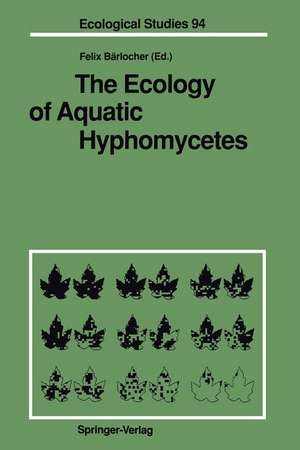The Ecology of Aquatic Hyphomycetes: Ecological Studies, cartea 94
Editat de Felix Bärlocheren Limba Engleză Paperback – 8 dec 2011
Din seria Ecological Studies
- 18%
 Preț: 1118.93 lei
Preț: 1118.93 lei -
 Preț: 553.72 lei
Preț: 553.72 lei - 18%
 Preț: 1680.55 lei
Preț: 1680.55 lei - 18%
 Preț: 1003.38 lei
Preț: 1003.38 lei - 20%
 Preț: 1004.71 lei
Preț: 1004.71 lei -
 Preț: 480.62 lei
Preț: 480.62 lei - 5%
 Preț: 752.26 lei
Preț: 752.26 lei - 15%
 Preț: 643.99 lei
Preț: 643.99 lei - 15%
 Preț: 644.18 lei
Preț: 644.18 lei - 15%
 Preț: 652.49 lei
Preț: 652.49 lei - 18%
 Preț: 789.83 lei
Preț: 789.83 lei -
 Preț: 382.36 lei
Preț: 382.36 lei - 15%
 Preț: 643.48 lei
Preț: 643.48 lei - 15%
 Preț: 646.30 lei
Preț: 646.30 lei - 15%
 Preț: 634.32 lei
Preț: 634.32 lei -
 Preț: 384.86 lei
Preț: 384.86 lei - 18%
 Preț: 789.98 lei
Preț: 789.98 lei - 15%
 Preț: 645.14 lei
Preț: 645.14 lei - 15%
 Preț: 649.39 lei
Preț: 649.39 lei - 18%
 Preț: 1005.43 lei
Preț: 1005.43 lei - 18%
 Preț: 949.23 lei
Preț: 949.23 lei - 15%
 Preț: 649.54 lei
Preț: 649.54 lei - 15%
 Preț: 643.34 lei
Preț: 643.34 lei - 15%
 Preț: 649.71 lei
Preț: 649.71 lei - 15%
 Preț: 638.76 lei
Preț: 638.76 lei - 18%
 Preț: 957.62 lei
Preț: 957.62 lei - 18%
 Preț: 1235.25 lei
Preț: 1235.25 lei - 18%
 Preț: 962.18 lei
Preț: 962.18 lei - 18%
 Preț: 949.23 lei
Preț: 949.23 lei - 15%
 Preț: 660.68 lei
Preț: 660.68 lei -
 Preț: 397.76 lei
Preț: 397.76 lei - 15%
 Preț: 638.24 lei
Preț: 638.24 lei - 18%
 Preț: 942.31 lei
Preț: 942.31 lei - 18%
 Preț: 1232.57 lei
Preț: 1232.57 lei - 15%
 Preț: 651.34 lei
Preț: 651.34 lei - 18%
 Preț: 952.72 lei
Preț: 952.72 lei - 18%
 Preț: 1834.27 lei
Preț: 1834.27 lei - 18%
 Preț: 1229.10 lei
Preț: 1229.10 lei -
 Preț: 423.95 lei
Preț: 423.95 lei - 18%
 Preț: 948.92 lei
Preț: 948.92 lei
Preț: 637.78 lei
Preț vechi: 750.33 lei
-15% Nou
Puncte Express: 957
Preț estimativ în valută:
122.08€ • 132.65$ • 102.61£
122.08€ • 132.65$ • 102.61£
Carte tipărită la comandă
Livrare economică 21 aprilie-05 mai
Preluare comenzi: 021 569.72.76
Specificații
ISBN-13: 9783642768576
ISBN-10: 3642768571
Pagini: 244
Ilustrații: XIV, 225 p.
Dimensiuni: 155 x 235 x 13 mm
Greutate: 0.35 kg
Ediția:Softcover reprint of the original 1st ed. 1992
Editura: Springer Berlin, Heidelberg
Colecția Springer
Seria Ecological Studies
Locul publicării:Berlin, Heidelberg, Germany
ISBN-10: 3642768571
Pagini: 244
Ilustrații: XIV, 225 p.
Dimensiuni: 155 x 235 x 13 mm
Greutate: 0.35 kg
Ediția:Softcover reprint of the original 1st ed. 1992
Editura: Springer Berlin, Heidelberg
Colecția Springer
Seria Ecological Studies
Locul publicării:Berlin, Heidelberg, Germany
Public țintă
ResearchCuprins
1 Research on Aquatic Hyphomycetes: Historical Background and Overview.- 1.1 Early Discoveries.- 1.2 Ingold’s Breakthrough.- 1.3 Significance of the Spore Shape.- 1.4 Advances in Taxonomy.- 1.5 Substrata Colonized by Aquatic Hyphomycetes.- 1.6 Geographical Distribution and Temperature Preferences.- 1.7 Nutrition.- 1.8 Sporulation.- 1.9 Role in Food Webs.- 1.10 Water Chemistry.- References.- 2 Recent Developments in Stream Ecology and Their Relevance to Aquatic Mycology.- 2.1 Longitudinal Variation: Distinct Zones or Gradual Replacement?.- 2.2 The River Continuum Concept.- 2.3 Hyporheos and Groundwater.- 2.4 Pristine Rivers and Their Boundaries.- 2.5 The Effects of Altitude and Latitude.- 2.6 Drift and Compensatory Mechanisms.- 2.7 Conclusions.- References.- 3 Community Organization.- 3.1 Theories of Community Structure.- 3.2 Fungal Ecology.- 3.3 Conclusions.- References.- 4 The Role of Woody Debris.- 4.1 Introduction.- 4.2 Occurrence of Aquatic Hyphomycetes on Wood.- 4.3 Role of Woody Debris in Aquatic Hyphomycete Life Cycles.- 4.4 Conclusions.- References.- 5 Anamorph-Teleomorph Relationships.- 5.1 Introduction.- 5.2 Techniques.- 5.3 Nomenclature.- 5.4 Synanamorphs.- 5.5 Entomophthorales with Branched Conidia.- 5.6 Ascomycete Teleomorphs.- 5.7 Basidiomycete Teleomorphs.- 5.8 Discussion.- References.- 6 Interactions with Invertebrates.- 6.1 Introduction.- 6.2 Effects of Fungi on Shredders.- 6.3 Effects of Shredders on Fungi.- 6.4 Conclusions.- References.- 7 Attachment and Germination of Conidia.- 7.1 Introduction.- 7.2 Conidial Attachment.- 7.3 Germination.- 7.4 Mucilage Secretion.- 7.5 Appressorium Formation.- 7.6 Influence of Attachment Structures on the Strength of Adhesion.- 7.7 Conclusions.- References.- 8 Water Chemistry.- 8.1 Introduction.- 8.2 Field Studies— Species Diversity and pH.- 8.3 Alkalinity and pH.- 8.4 Nitrogen and Phosphorus.- 8.5 Species Composition and Water Chemistry.- 8.6 Further Research.- References.- 9 Human Interference.- 9.1 Introduction.- 9.2 Organic Pollution.- 9.3 Heavy Metals.- 9.4 Pesticides.- 9.5 Acid Precipitation.- References.- 10 Research on the Indian Subcontinent.- 10.1 Introduction.- 10.2 Distribution.- 10.3 Regional Differences.- 10.4 Substrata.- 10.5 Survival Outside Streams.- 10.6 Other Studies.- 10.7 Conclusions.- References.- 11 Conclusions and Outlook.- References.














